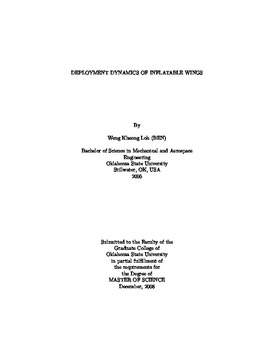| dc.contributor.advisor | Jacob, Jamey | |
| dc.contributor.author | Loh, Weng Kheong (Ben) | |
| dc.date.accessioned | 2014-04-17T19:53:00Z | |
| dc.date.available | 2014-04-17T19:53:00Z | |
| dc.date.issued | 2008-12-01 | |
| dc.identifier.uri | https://hdl.handle.net/11244/9983 | |
| dc.description.abstract | Dynamic deployment of inflatable wings were investigated through laboratory, wind tunnel and flight testing. The goal of the research is to design an in-flight morphing wing aircraft using semi-span inflatable wings that morphs from low aspect ratio to high aspect ratio. Full scale pre-inflated flight tests were successfully conducted for an inflatable wing manufactured from polyurethane coated nylon that varies the aspect ratio of a small unmanned vehicle from approximately 3.4 to over 8.5, an 150% increase. A wing sleeve made of silicon tape was used to attached the semi-span inflatable wing section to the wing tip of the inboard rigid wing. Prior to in-flight deployment tests, wind tunnel tests were conducted to investigate the impact of dynamic pressure during deployment. Three wing designs were investigated: wing alone (WA), wing with stiffening elements (WSE), and wing with deployment control elements (DCE). Compressed air was used as the pressurized gas for inflation. Aerodynamic load and pressure measurements were made to determine the performances of deployment by varying angles of attack, free-stream velocities and inflation pressure while simultaneous recording deployment shape with high speed video. Regardless of the wing design and deployment behavior, in all deployments tests the wing was successfully deployed to its final shape at its design pressure. The WA contains no solid structure and solely relies on internal pressure to maintain shape. The WSE was reinforced with strips of flexible tape to increase structural stiffness over the WA design. However, both wing designs showed flapping and folding due to the aerodynamic loads during deployment. This unstable behavior was successfully mitigated by using hook and loop fasteners as DCE. The DCE test results showed a systematic and stable deployment even as the wing was deployed at stall conditions. Multiple arrangements with different lengths and surface areas were investigated to improve deployment performance. Full scale static and dynamic deployment tests using DCE have demonstrated that the deployment is symmetric and is able to maintain its structural integrity under dynamic pressure. However, both the wing internal pressure and surface roughness were found to impact the lift efficiency of the inflatable wing and lift could be maximized by using a pressure lower than the design pressure. Ground test under flight conditions demonstrated successful deployment. An onboard inflation system has been developed using a COTS solenoid valve and CO2 canister. | |
| dc.format | application/pdf | |
| dc.language | en_US | |
| dc.publisher | Oklahoma State University | |
| dc.rights | Copyright is held by the author who has granted the Oklahoma State University Library the non-exclusive right to share this material in its institutional repository. Contact Digital Library Services at lib-dls@okstate.edu or 405-744-9161 for the permission policy on the use, reproduction or distribution of this material. | |
| dc.title | Deployment Dynamics of Inflatable Wings | |
| dc.type | text | |
| dc.contributor.committeeMember | Arena, Andrew S. | |
| dc.contributor.committeeMember | Delahoussaye, Ronald | |
| osu.filename | Loh_okstate_0664M_10147.pdf | |
| osu.college | Engineering, Architecture, and Technology | |
| osu.accesstype | Open Access | |
| dc.description.department | Mechanical & Aerospace Engineering | |
| dc.type.genre | Thesis | |
